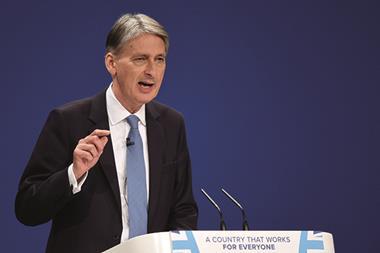If Philip Hammond chooses to stimulate housing in his 22 November Budget, he should study the record of his predecessors and stimulate supply rather than demand.

Chancellors down the years - Conservatives in particular, it seems - have not been able to keep their mitts off the housing market. Their efforts have merely distorted house prices in one direction or another and rarely stimulate supply.
If one rule needs nailing on any Chancellor’s desk it is: any fiscal incentive focused on consumer finance of housing merely ends up in house prices.
Hammond’s immediate predecessor, George Osborne, did not appear to have followed that dictum. During his six-year tenure, he made three huge interventions, the repercussions of which are still being felt, in pricing and the delivery of homes.
His first was Help to Buy (HTB). The scheme, whereby the taxpayer provides an equity loan of up to 20% of the price of a new home (and 40% in London), has been criticised by many politicians and observers for stoking prices. It was introduced in 2013 and, probably to its credit, briefly helped break the log jam in higher loan-to-value mortgages for first-time buyers (FTBs). I am far from alone in the view it has become something of a monster that housebuilders cannot wean themselves off (“Help to Buy junkies” was the description in last month’s Property Week column by former Tory grandee Steve Norris).
I have yet to see any convincing evidence against my recent study for Stockdale Securities that indicated HTB has pushed up prices of new-build homes, particularly for FTBs; I had better not rekindle my contention that, four years on, it has not pushed up delivery of homes much above what developers were already planning for fear of prompting another angry missive from the Home Builders Federation.
Social housing own goal
Osborne’s second big intervention in 2015 chopped the legs from under the largest housing associations’ development plans, by tearing up his own 10-year formula for annual social rent rises. This had been set in 2013 at inflation plus 1% for 10 years, but was replaced with four years of annual 1% actual cuts.
This saved the Treasury £1.5bn but, at least temporarily, put the kibosh on their financing of imminent building plans, resulting in predictions of a consequent shortfall of new affordable homes ranging from 14,000 (Office for Budget Responsibility) to at least 27,000 (National Housing Federation).

Some of the more enterprising housing associations have rejigged their financial models to mitigate the impact, but this has resulted in a higher proportion of their lowered volumes being taken up by more profitable, but pricy, shared ownership housing. Communities secretary Sajid Javid recently prompted sighs of relief in the sector when he announced a return to rent increases, but only after the four-year process has finished.
Broadside number three was the realignment of stamp duty, with houses below £1m requiring less and those above, more. All very egalitarian in intent. In practice, it has gummed up the market. Among the unintended effects has been that downsizers have struggled to sell homes to families who found it hard to scrape together tens of thousands in tax for modest suburban homes in London.
Hammond has the ingredients for a major supply-side response. The key components are laid out in the housing white paper. It is a multi-pronged, multi-tenure approach aimed primarily at volume growth, involving build-to-rent, various hues of social housing, even council house building and, yes, private ownership.
But the best approach to the latter is that the market will ultimately look after itself. Hammond will do well to remember Margaret Thatcher’s own famed injunction: “You can’t buck the market. If you try, the market will buck you.”






























No comments yet